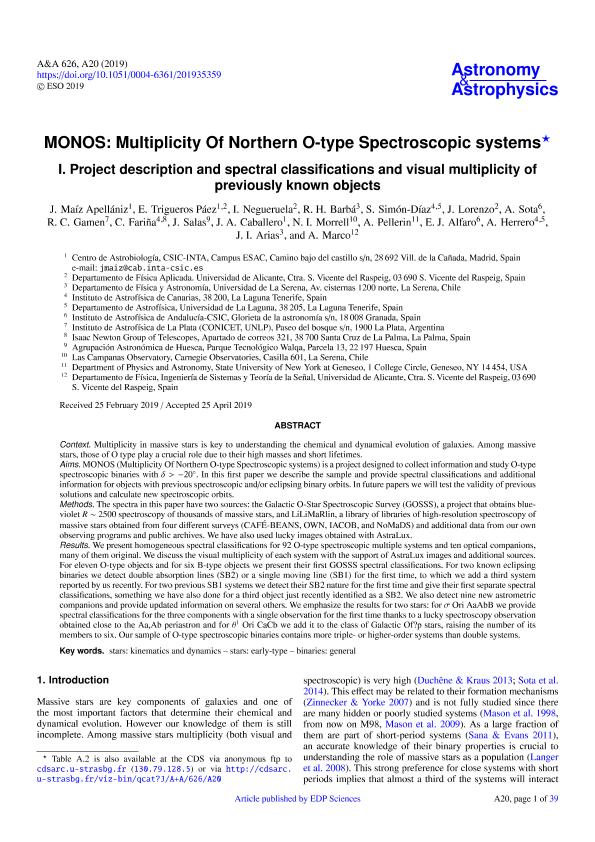Artículo
MONOS: Multiplicity of Northern O-type Spectroscopic systems: I. Project description and spectral classifications and visual multiplicity of previously known objects
Maíz Apellániz, Jesús; Trigueros Páez, E.; Negueruela, Ignacio; Barbá, Rodolfo; Simón Díaz, S.; Lorenzo, Javier; Sota, Alfredo; Gamen, Roberto Claudio ; Fariña, Cecilia
; Fariña, Cecilia ; Salas, J.; Caballero, Javier Alberto; Morrell, Nidia Irene
; Salas, J.; Caballero, Javier Alberto; Morrell, Nidia Irene ; Pellerin, Anne; Alfaro Navarro, Emilio Javier; Herrero, Artemio; Arias, Julia Ines
; Pellerin, Anne; Alfaro Navarro, Emilio Javier; Herrero, Artemio; Arias, Julia Ines ; Marco, Amparo
; Marco, Amparo
 ; Fariña, Cecilia
; Fariña, Cecilia ; Salas, J.; Caballero, Javier Alberto; Morrell, Nidia Irene
; Salas, J.; Caballero, Javier Alberto; Morrell, Nidia Irene ; Pellerin, Anne; Alfaro Navarro, Emilio Javier; Herrero, Artemio; Arias, Julia Ines
; Pellerin, Anne; Alfaro Navarro, Emilio Javier; Herrero, Artemio; Arias, Julia Ines ; Marco, Amparo
; Marco, Amparo
Fecha de publicación:
05/06/2019
Editorial:
EDP Sciences
Revista:
Astronomy and Astrophysics
ISSN:
0004-6361
Idioma:
Inglés
Tipo de recurso:
Artículo publicado
Clasificación temática:
Resumen
Context. Multiplicity in massive stars is key to understanding the chemical and dynamical evolution of galaxies. Among massive stars, those of O type play a crucial role due to their high masses and short lifetimes. Aims. MONOS (Multiplicity Of Northern O-type Spectroscopic systems) is a project designed to collect information and study O-type spectroscopic binaries with δ > −20◦ . In this first paper we describe the sample and provide spectral classifications and additional information for objects with previous spectroscopic and/or eclipsing binary orbits. In future papers we will test the validity of previous solutions and calculate new spectroscopic orbits. Methods. The spectra in this paper have two sources: the Galactic O-Star Spectroscopic Survey (GOSSS), a project that obtains blueviolet R ∼ 2500 spectroscopy of thousands of massive stars, and LiLiMaRlin, a library of libraries of high-resolution spectroscopy of massive stars obtained from four different surveys (CAFÉ-BEANS, OWN, IACOB, and NoMaDS) and additional data from our own observing programs and public archives. We have also used lucky images obtained with AstraLux. Results. We present homogeneous spectral classifications for 92 O-type spectroscopic multiple systems and ten optical companions, many of them original. We discuss the visual multiplicity of each system with the support of AstraLux images and additional sources. For eleven O-type objects and for six B-type objects we present their first GOSSS spectral classifications. For two known eclipsing binaries we detect double absorption lines (SB2) or a single moving line (SB1) for the first time, to which we add a third system reported by us recently. For two previous SB1 systems we detect their SB2 nature for the first time and give their first separate spectral classifications, something we have also done for a third object just recently identified as a SB2. We also detect nine new astrometric companions and provide updated information on several others. We emphasize the results for two stars: for σ Ori AaAbB we provide spectral classifications for the three components with a single observation for the first time thanks to a lucky spectroscopy observation obtained close to the Aa,Ab periastron and for θ 1 Ori CaCb we add it to the class of Galactic Of?p stars, raising the number of its members to six. Our sample of O-type spectroscopic binaries contains more triple- or higher-order systems than double systems.
Palabras clave:
BINARIES
,
EARLY-TYPE
,
GENERAL
,
KINEMATICS AND DYNAMICS
,
STARS
,
STARS
Archivos asociados
Licencia
Identificadores
Colecciones
Articulos(IALP)
Articulos de INST.DE ASTROFISICA LA PLATA
Articulos de INST.DE ASTROFISICA LA PLATA
Citación
Maíz Apellániz, Jesús; Trigueros Páez, E.; Negueruela, Ignacio; Barbá, Rodolfo; Simón Díaz, S.; et al.; MONOS: Multiplicity of Northern O-type Spectroscopic systems: I. Project description and spectral classifications and visual multiplicity of previously known objects; EDP Sciences; Astronomy and Astrophysics; 626; 5-6-2019; 20-56
Compartir
Altmétricas



